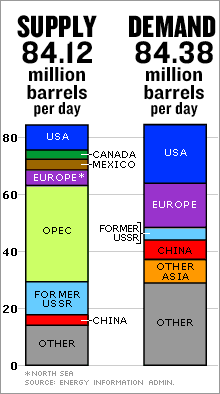Solar energy doesn't have to mean solar panels. Solar energy is just the process of converting sunlight to electricity. Well, "just" doesn't do justice to it, since there are many ways to do the conversion.
Southern California Edison has agreed to make a huge purchase that underscores a particular technology, Stirling Engines.
The Stirling engine works by the repeated heating and cooling of a sealed amount of working gas, usually air or other gases such as hydrogen or helium. The gas follows the behaviour described by the gas laws which describe how a gas' pressure, temperature and volume are related. When the gas is heated, because it is in a sealed chamber, the pressure rises and this then acts on the power piston to produce a power stroke. When the gas is cooled the pressure drops and this means that less work needs to be done by the piston to recompress the gas on the return stroke, giving a net gain in power available on the shaft. The working gas flows cyclically between the hot and cold heat exchangers.
The working gas is sealed within the piston cylinders, so there is no exhaust gas, (other than that incidental to heat production if combustion is used as the heat source). No valves are required, unlike other types of piston engines.
The maker is Stirling Energy Systems.
World's largest solar installation to use Stirling engine technology: 20-year purchase agreement between Southern California Edison and Stirling Energy Systems, Inc. will result in 20,000+ dish array, covering 4,500 acres, and capable of generating 500 MW -- more electricity than all other U.S. solar projects combined.
UPDATE Aug 14, 2005
Start-up sees new dawn for old solar tech (Published: August 14, 2005, 6:00 AM PDT, By Claire Poole, news.cnet.com)
The CEO of the company is "David Slawson [who] is an unabashed granola-crunching, tree-hugging New Age apostle whose livelihood rests on matriculating massage therapists to his alternative health care college in Portland, Ore.". I suppose that Claire Poole, the author of the C|NET article, is suprised or shocked to find a new-ager who's also into technology. Speaking as one (ahem, I work for a silicon valley high tech company, I do massage therapy, and I build electric vehicles) I don't find it strange, but instead I find it exciting to see someone else on a similar path and make it big.
Fortunately the article says a lot more than that snippet, and goes into some intriguing details.
Unlike the internal combustion engine, the Stirling engine never burns any fuel and is consequently a thoroughly clean technology. Today it's used in extremely high-tech environments, such as within nuclear-powered submarines, but has never been deployed on a broader commercial basis.
They say that the Stirling Engine technology is 3x as efficient as regular photovoltaic solar panels.
I remember doing that kind of calculation in high school physics, so let me relate what I recall. First, you start with the energy produced by the Sun. It's light, and as it spreads out from the Sun the energy spreads out as well. At the Sun's surface the quantity of energy is great, but as you move outward the quantity of energy at any one spot diminishes. That's why the surface of Venus is 800 degrees whereas here it's nice. Taking the model further, there's a some loss as the light goes through the atmosphere, etc. Every step along the way is a calculation and the numbers are fairly well known.
What you end up with is a rule of thumb about the amount of energy that reaches the ground at any given spot. The amount varies based on cloud cover, distance from the equator, altitude, etc. Hence, deserts, especially high altitude ones, are valuable for solar energy projects.
Each square meter of ground receives X amount of solar energy (light and heat). That energy is equivalent to a certain amount of electrical energy. However, to make it into electricity requires conversion. Photovoltaic cells do it in silicon, plants do it using photosynthesis (except they don't make electricity), and a stirling engine does it with mirrors and a heated fluid.
What you have is solar energy coming in, and electrical energy going out. If you know the theoretical maximum electrical energy equivalent to the solar energy, then its easy to calculate the percentage based on the actual electrical energy coming out of the system.
Current photovoltaic cells have 8%-15% efficiencies. To have 3x the efficiency that's in the range of 25-50%, and this range has been a dream of solar energy researchers for quite a long time.
Some other salient points of the system ....
Unlike conventional power plant production, this system can be turned on one engine at a time. In a conventional power plant you have to build a large building, wire up all the turbines, etc, all before you can turn on the system and start selling power. In this stirling engine system each one is independent, and is fully operational once built and installed. Building each one takes a team of five people four hours to set up and get running, which is rather amazing if you ask me.
It also appears the Southern California Edison project referred to above is down the road a bit. If nothing else, the company requires funding to build a production plant. In any case the C|NET article describes a smaller project in Phoenix that's to be built first before this large one.

